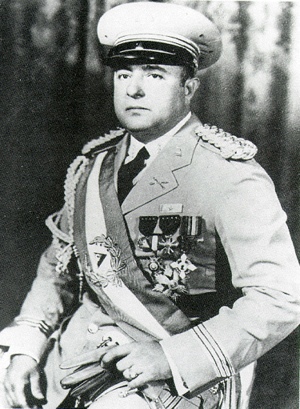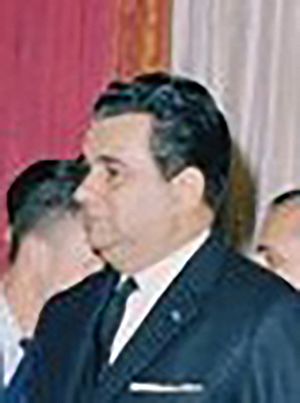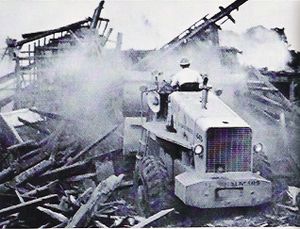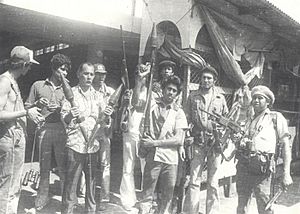Somoza family facts for kids
Quick facts for kids Somoza family |
|
|---|---|
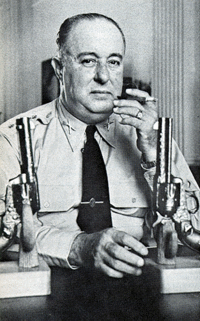
Anastasio Somoza García, founder of the Somoza family dictatorship
|
|
| Country | Nicaragua |
| Founded | 1 January 1936 |
| Founder | Anastasio Somoza García |
| Final ruler | Anastasio Somoza Debayle |
| Titles | President of Nicaragua Head of the National Guard |
| Members |
|
| Connected members |
|
|
Republic of Nicaragua
República de Nicaragua
|
|||||||||
|---|---|---|---|---|---|---|---|---|---|
| 1936–1979 | |||||||||
|
|
|||||||||
|
Anthem: Salve a ti, Nicaragua (Spanish)
"Hail to Thee, Nicaragua" |
|||||||||
 |
|||||||||
| Capital | Managua | ||||||||
| Common languages | Spanish | ||||||||
| Religion | Roman Catholicism | ||||||||
| Government | Hereditary military dictatorship | ||||||||
| President of Nicaragua | |||||||||
|
• 1936–1937
|
Carlos Alberto Brenes | ||||||||
|
• 1937–1947; 1950–1956
|
Anastasio Somoza García | ||||||||
|
• 1947
|
Leonardo Argüello Barreto | ||||||||
| Legislature | National Congress of Nicaragua | ||||||||
| Historical era | Interbellum, World War II, Cold War | ||||||||
|
• 1936 Nicaraguan presidential election
|
January 1, 1936 | ||||||||
|
• Nicaraguan Revolution
|
1960s | ||||||||
|
• Sandinista's Seizure of Power
|
July 17, 1979 | ||||||||
| Currency | Nicaraguan córdoba | ||||||||
| ISO 3166 code | NI | ||||||||
|
|||||||||
The Somoza family (Spanish: Familia Somoza) was a powerful political family in Nicaragua. They ruled the country for 43 years, from 1936 to 1979. Their rule was a dictatorship, meaning one family had complete control.
The family's power began with Anastasio Somoza García. His two sons, Luis Somoza Debayle and Anastasio Somoza Debayle, continued his rule. Even when a Somoza wasn't directly the president, they still controlled the country. They did this by using "puppet presidents" and by leading the National Guard, which was the country's main military force.
The Somoza family tried to make Nicaragua more modern. However, their rule also involved harsh control and unfairness. Over 40 years, the family became very rich. They made money through business deals, taking land, and misusing money sent as foreign aid. The United States government often supported the Somoza family.
Eventually, the Somoza family was overthrown by a group called the Sandinista National Liberation Front (FSLN). This happened during the Nicaraguan Revolution. Many people in Nicaragua were unhappy with the Somoza government. This unhappiness grew after a big earthquake hit the capital city, Managua, in 1972.
Anastasio Somoza Debayle was in charge of helping after the earthquake. But he used his power to take money and resources meant for aid. This made people even angrier. Different groups began to oppose the Somoza government. Some tried to talk things out, while others wanted a rebellion. When talks failed, the rebellion grew stronger. On July 17, 1979, Anastasio Somoza Debayle resigned as president. This marked the end of the Somoza family's long rule.
The family became very wealthy. They owned about 23 percent of all the land in Nicaragua by the 1970s. It's believed their wealth reached around $533 million. This was a huge amount, equal to half of Nicaragua's national debt at the time.
Three members of the Somoza family served as President of Nicaragua:
- Anastasio Somoza García "Tacho" (1896–1956; President 1937–1947, 1950–1956), the father.
- Luis Somoza Debayle (1922–1967, President 1956–1963), his oldest son.
- Anastasio Somoza Debayle "Tachito" (1925–1980, President 1967–1972, 1974–1979), his second son.
Other important family members included:
- José R. Somoza, Anastasio Somoza Debayle's half-brother.
- Hope Portocarrero, Anastasio Somoza Debayle's wife.
- Lillian Somoza de Sevilla Sacasa, Anastasio Somoza García's daughter.
- Isabel Urcuyo (1924–2014), Luis Somoza Debayle's wife.
- Anastasio Somoza Portocarrero, a son of Anastasio Somoza Debayle.
Contents
Anastasio Somoza García: The Founder
Anastasio Somoza García was born on February 1, 1898. He came from a rich family that grew coffee. He studied in the United States, where he learned English. There, he also met his future wife, Salvadora Debayle Sacasa. Her family was also wealthy and had political connections.
After returning to Nicaragua, Anastasio Somoza García joined a political uprising in 1926. He worked as an interpreter during peace talks with the United States. This helped him build a good reputation with American officials. When José María Moncada became president in 1929, Somoza García held several important jobs.
The United States Marines helped create Nicaragua's National Guard. Somoza García became an officer in this new military force. After the Marines left in 1933, he became the Head of the National Guard. This gave him a lot of power.
In 1936, Anastasio Somoza García used his control of the National Guard to take over the government. This is called a military coup. He removed President Juan Bautista Sacasa from power. A week later, he was chosen to be the next president. He officially took office on January 1, 1937.
Anastasio Somoza García was the President of Nicaragua for 19 years. He was in charge for most of this time. Sometimes, he would let other people be president, but he still controlled them from behind the scenes. To keep the National Guard loyal, he gave important jobs to his family and friends.
He also worked to keep the support of the United States. His government often agreed with U.S. foreign policy. Somoza García focused on growing Nicaragua's economy. He wanted to modernize the country. His plans focused on increasing exports and building new roads and public services. These policies helped his own family's wealth a lot, but they didn't do much for ordinary people.
Anastasio Somoza García was shot and killed in 1956. A poet named Rigoberto López Pérez shot him. He died a few days later on September 29, 1956.
Luis Somoza Debayle: A Softer Approach
Luis Somoza Debayle was the oldest son of Anastasio Somoza García. He was born on November 18, 1922, in León, Nicaragua. He also studied in the United States. By the age of 18, he was a captain in the National Guard. He became a member of Congress in 1950.
In 1956, Luis became the President of Congress. This meant that if the president's job became empty, he would take over. When his father was killed in 1956, Luis Somoza Debayle became the acting president. He was officially elected president in 1957, though the elections were not entirely fair. He became the 26th President of Nicaragua.
During his time as president, Luis Somoza Debayle tried to modernize Nicaragua. He also tried to make the government more open. In 1959, he brought back a rule that stopped presidents from being re-elected right away. It also stopped relatives from taking over the presidency. This rule meant his younger brother, Anastasio Somoza Debayle, couldn't run for president in 1963.
In 1960, Nicaragua joined with other Central American countries to form a common market. This helped Nicaragua's economy grow quickly. Luis also continued his father's friendly relationship with the United States. His government was against the Cuban Revolution. He also played a part in the failed Bay of Pigs Invasion in 1961.
Luis Somoza Debayle also started some social and economic changes. These included new programs for housing, education, and social security. These changes created some jobs. However, they mostly helped the rich and didn't do much for poor Nicaraguans.
Luis Somoza Debayle's time as president ended in 1963. After that, he still controlled the country through "puppet presidents" until his death. He died of a heart attack in 1967.
Anastasio Somoza Debayle: The Final Ruler
Anastasio Somoza Debayle was the youngest son of Anastasio Somoza García. He was born on December 5, 1925. He also received an American education, including at West Point, a famous military academy. He became the Head of the National Guard in 1955.
Anastasio Somoza Debayle's first term as president was from 1967 to 1972. His way of leading was different from his older brother's. It was more like his father's stricter style of personal rule. He used military power and used his public office to get rich. He allowed corruption and protected his officers from being punished. He became known for violating human rights. He also replaced skilled government workers with his own friends who weren't as qualified. By the 1970s, the government became very corrupt and didn't work well.
His first term was supposed to end in 1971. But Anastasio Somoza Debayle changed the rules to allow himself to stay president for another year. Between his first and second terms, Somoza ruled through other leaders. He made a deal with Fernando Agüero, a leader of another political party. They agreed that power would be given to a group of three leaders, called a triumvirate. This group would rule temporarily while a new election was held and a new constitution was written. When this change happened in 1972, Somoza went back to being the Head of the National Guard. He was then re-elected as president in 1974.
The end of the Somoza family's rule happened during Anastasio Somoza Debayle's second term. He resigned as president in July 1979. He was killed in September 1980.
The Downfall of the Somoza Family
The Managua Earthquake of 1972
On December 23, 1972, a powerful earthquake hit Managua, the capital city of Nicaragua. The earthquake killed 10,000 people. It left many people without homes and destroyed buildings. Even though he wasn't president at the time, Anastasio Somoza Debayle quickly took charge. He created the National Emergency Committee and made himself its head.
This put him in a position to control money and help sent from other countries. But he used this power in a dishonest way to benefit himself. The international aid money meant for victims often ended up with the Somoza family. For example, money for housing went to build fancy homes for National Guard officers. Homeless people were given quickly built wooden shacks.
Somoza also allowed the National Guard to steal from businesses that were still standing. He bought land and businesses that would become very valuable during the rebuilding. The promised rebuilding of the city never really happened. Roads, drainage systems, and public transportation were poorly managed.
After this, people openly started to show their unhappiness with the Somoza government. Even rich business owners, who had supported Somoza before, began to turn against him. Some of them even started giving money to the FSLN, a group that opposed the government.
The Rise of the FSLN

The Sandinista National Liberation Front (FSLN) was officially formed in 1961. It started as a group of students who were against the government. By the early 1970s, the FSLN had gained enough support to start small military actions.
On December 27, 1974, a group of FSLN fighters took over the home of a former government official. They held many important Nicaraguan officials hostage, including some of Somoza's relatives. The FSLN made their demands clear. An agreement was reached on December 30, 1974. The FSLN received $1 million in ransom money. They also had their message read on the radio and printed in a newspaper called La Prensa. In addition, 14 FSLN prisoners were released and taken to Cuba with the fighters. This successful operation made the FSLN very popular and hurt the Somoza government's image.
Human Rights Concerns
Anastasio Somoza Debayle reacted to the growing opposition by declaring a state of emergency. He also stopped newspapers from printing freely. During this time, the National Guard was involved in widespread torture, unfair arrests, and killings of opponents and ordinary people. These actions led to strong criticism of the Somoza government both inside Nicaragua and from other countries. This criticism also helped the FSLN gain more support.
In 1977, the United States government, led by President Jimmy Carter, said it would only give military help to Nicaragua if human rights improved. This pressure led Somoza to lift the state of emergency and allow freedom of the press again in September 1977.
Growing Opposition and Rebellion
With freedoms restored, newspapers could report on the opposition's activities and the government's human rights issues. This made more people unhappy with Somoza and increased support for those against him.
The FSLN attacked National Guard bases across the country. They also gained support from a group called Los Doce, which included important Nicaraguan leaders. This group wanted the FSLN to be part of any new government after Somoza.
On January 10, 1978, Pedro Joaquín Chamorro was killed. He owned La Prensa newspaper and led an opposition group. Many people blamed Somoza's son and the National Guard for his death. This led to huge protests against the Somoza government.
Two Ways to Find a Solution
Many groups opposed the Somoza government. In May 1978, several groups joined together to form the Broad Opposition Front (FAO). The FAO wanted to find a peaceful solution through talks and negotiations. They organized strikes to put pressure on the government. The FSLN, however, had a different idea. They formed the United People's Movement, which believed in fighting and a nationwide rebellion to overthrow the dictatorship.
In August 1978, the FSLN took over the National Palace. They held government officials and members of Congress hostage. Somoza had no choice but to agree to their demands. This further damaged Somoza's image and weakened his power.
By late 1978, the FAO's talks had failed. This made the rebellion movement much stronger. Many members left the FAO. The peace talks officially ended in January 1979. Somoza refused to let people vote on his rule and insisted on staying in power until 1981. As a result, the rebellion gained more strength, and fighting increased.
In February 1979, the FSLN used the failure of talks to gain more support. They formed the National Patriotic Front, which included many different groups. Heavy fighting broke out across Nicaragua. The FSLN launched its final attack in May 1979. The National Guard lost control of many parts of the country. By the end of June, most of Nicaragua was under FSLN control.
The Somoza government was losing political, international, and military support. This forced Anastasio Somoza Debayle to think about resigning. A temporary Nicaraguan government was set up in Costa Rica on June 18, 1979. This new government promised a mixed economy, a neutral foreign policy, and political freedom.
Somoza's Resignation
On July 17, 1979, Anastasio Somoza Debayle resigned as President of Nicaragua. He then fled to Miami. This marked the end of the Somoza family's long rule. Somoza handed power to Francisco Maliano Urcuyo, who was then supposed to transfer the government to the new leaders. Somoza lived in Paraguay until September 17, 1980, when he was killed by Argentine fighters.
Timeline of the Somoza Family Rule
See also
 In Spanish: Familia Somoza para niños
In Spanish: Familia Somoza para niños
- List of political families




